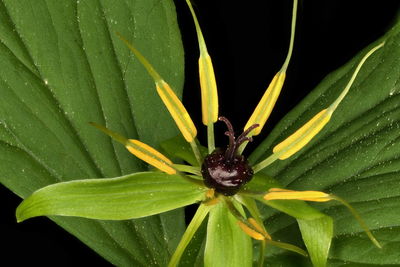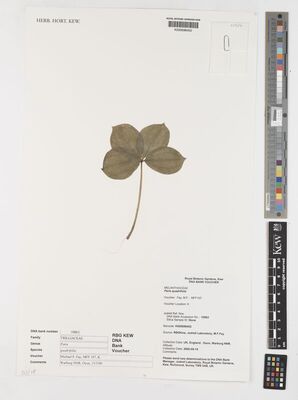Geography and distribution
The native range of Paris quadrifolia comprises the boreal and temperate areas of Europe and extends eastwards to western Asia, western Siberia and the Himalaya.
Description
Overview: A perennial woodland herb, 25-40 cm tall, with a rhizome (underground stem).
Leaves: Four (often 3-8) deep green leaves, broadly obovate, measuring 6.0-10.0 × 2.0-5.5 cm. The leaves are in a single whorl at the top of the stem and are stalkless or with only a short stalk.
Flowers: Four broad green sepals and four narrow yellow-green petals, topped with a crown of 8 (sometimes up to 12) golden-yellow stamens. The ovary has four chambers and four protruding styles.
Fruits: Black, spherical berry, approximately 13 mm in diameter, containing on average 34 seeds.
Seeds: Dark brown, egg-shaped, 2.5×1.5 mm.
'Herba paris'
The common name 'herba paris' was first used in 1544 by Italian botanist Pierandrea Matthioli in his Italian edition of commentaries on Dioscorides' Materia Medica . Herb paris also appears in Gerard's Herbal of 1636 as an antidote to highly toxic substances such as arsenic or mercury. Other common names allude to its black berry (devil-in-a-bush) or to its connections with love - the four leaves are paired like lovers and also bear a resemblance to the loops of the true lover's knot.
Threats and conservation
Paris quadrifolia is in decline in Europe due to a reduction in broadleaved woodland, its primary habitat. Native woodland is frequently cleared to make way for conifer plantations and construction of new roads and buildings, and although this is often mitigated by the planting of new woodlands, herb paris has limited dispersal abilities and is slow to colonise new areas. The conservation of ancient broadleaved woodland is therefore key to preventing further decline of the species.
A genetic giant
Paris quadrifolia has a large quantity of DNA in its cells (with a 2C DNA value of 60 picograms) but scientists at Kew's Jodrell Laboratory recently discovered that the related species Paris japonica has the largest genome on record, with well over twice this amount, at a staggering 152 picograms.
Uses
Paris quadrifolia is cultivated as an ornamental and makes an attractive addition to a woodland garden. Its medicinal use is almost exclusively confined to homeopathy.
Millennium Seed Bank: Seed storage
The Millennium Seed Bank Partnership aims to save plant life worldwide, focusing on plants under threat and those of most use in the future. Seeds are dried, packaged and stored at a sub-zero temperature in our seed bank vault.
Two collections of Paris quadrifolia seeds are held in Kew's Millennium Seed Bank based at Wakehurst in West Sussex.
Cultivation
Herb paris requires a neutral or only slightly acidic soil that is deep, moist, well drained and humus-rich. It will do best in a partly shaded position where the soil stays moist throughout the year.
It spreads vegetatively by rhizomes, which can be divided to propagate the plant. Alternatively, seed can be collected and sown in containers immediately after harvesting.
This species at Kew
Herb paris can be seen growing in Kew's Woodland Garden (at the southern end of the Plant Family Beds).
Dried and alcohol-preserved specimens of Paris quadrifolia are held in Kew's Herbarium, where they are available to researchers by appointment.
Further details, including images, are available online in Kew's Herbarium Catalogue.
View details and images

_fullsize.jpg)
























